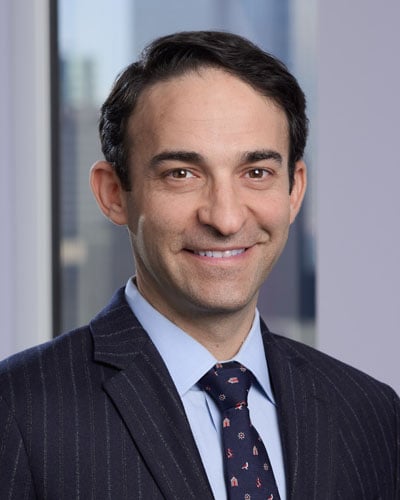Following up on Ropes & Gray’s recent article in Institutional Real Estate Americas, on this podcast, private capital transactions partner Sarah Schaffer Raux joins real estate and investment transactions partner David Kaye and counsel Pete Scherer to discuss the emerging trend of institutional real estate investors looking beyond traditional real estate joint ventures to create expanded relationships with their operating partners, often through the use of hybrid investment structures.
Transcript:
Pete Scherer: Hi, my name is Pete Scherer, and I am a counsel here at the Ropes & Gray real estate group, with a broad-ranging practice focused primarily on equity investments in real estate across all asset classes. I'm joined today by my colleagues, Sarah Schaffer Raux and David Kaye.
Sarah Schaffer Raux: Hi, Pete. Happy to join in today. This is Sarah Schaffer Raux—I'm a partner in Ropes & Gray's private capital transactions group, and I focus on advising institutional investors on the full range of private control, joint venture (JV), and minority investments.
David Kaye: Hi, everyone. My name's David Kaye—I'm a partner in the real estate group focusing on equity investments, and in particular, programmatic joint ventures, including acquisitions, dispositions, and financing, which are also across all geographies and asset classes.
Pete Scherer: We're here today to discuss some emerging trends that we're starting to see in the real estate space, specifically, some adaptations that have emerged in the traditional real estate JV model. David, why don't we start with you to give us a quick overview of the trend and the transaction structures that we're starting to see in the marketplace?
David Kaye: Sure—thanks, Pete. Just taking a quick step back, I think most people listening to this podcast are aware of the traditional joint venture model where an operating partner provides the expertise, the access to deals, knowledge of local markets, as well as the ability to manage the assets; where the capital provider provides the money to acquire, own, and operate the assets—and, for some up-and-coming operating partners, to help them build out their back office.
As the commercial real estate market becomes more crowded and competitive than ever, institutional investors are looking for creative access to real estate investments outside of the traditional joint venture model. And while these access points are not necessarily novel, we are seeing an uptick in the number of institutional investors who are now reexamining the traditional model, and this is due to a confluence of factors.
In today’s market, there's expanding complexity around operating partners syndicating their co-investment, which is causing leakage around both economics and control. Now, there have always been restrictions on principals' ability to syndicate their interests in the operating partner. But an operating partner's view is that, due to their need for capital to be able to keep up with the market, fund capital calls to invest in the assets that it identifies, and more generally, manage business, they need additional capital and will take it from wherever they can get it. From an operating partner’s perspective, if they can raise their co-investments with institutional money, they do not need to engage in fragmented fundraising from friends and family, crowdfunding, etc.
And capital partners have begun asking, "Why should a third party, especially a third-party institutional investor, benefit from the value we co-created through our JV, and share in our economics, and more importantly, potentially diminish the alignment of interests between me and my operating partner?"
There's also been a trend of judicial and regulatory hostility toward traditional, restrictive covenants. In the traditional model for a programmatic joint venture, a capital partner would typically rely on some type of exclusivity, which may be in the form of a non-compete, restriction on investment in a particular asset class, radius restriction, or a simple ROFO (right of first offer), or it could be all of the above. As courts have become more sympathetic to operating partners and view restrictive covenants, even narrowly tailored ones, as being against public policy, capital partners are looking for ways to maintain market share of the assets in which they invest, and ensure that the operating partner is not competing with our joint venture. And, of course, there's always pressure from limited partners of the capital partner to secure market intelligence and capture as much of the economics of a deal as possible.
As a result of these headwinds being faced by capital partners, there are a few different avenues that could be explored in terms of avoiding leakage of economics, control, and judicial or regulatory interventions. These could include preemptive rights over operating partners' future investment vehicles. This is where the capital partner has the right to participate—potentially at a discount—in a future investment vehicle that's sponsored by the operating partner. In this instance, while a capital partner would essentially be a passive LP in a fund, it would not have the same governance, control, and liquidity rights as in a JV. They would still have access to the pipeline and informational advantages with respect to the investments that could potentially compete with the JV.
The capital partner could also co-invest in the operating partner of the joint venture. Now, put simply, the capital partner acquires an interest in the operating partner. This avoids economic and market intelligence leaking to third parties, which could be competitors of the joint venture. This could also be viewed as a discount on promote. While the operating partner will ultimately have less skin in the game, and therefore, increase the exposure of the capital partner, it is still better than a competitor having that skin in the game and the ability to influence the operating partner in its management decisions with respect to the assets.
A more hands-on approach would be to invest in the operating partner's management company, as opposed to the operating partner's entity in the joint venture. This would provide access to fees from all transactions in which the operating partner invests, and the ability to co-invest in deals with other third parties. Now, this affords better reporting and visibility into the operating partner's business. And at a more intangible level, it builds soft power, making the capital partner the potential first choice to the extent financing or other capital is needed, potential MFN (most-favored-nation) treatment on future investments, and the ability to participate in fee income and promote.
A more intense approach would be forming a captive management company, where the capital partner becomes a vertically integrated operating company for a particular asset class. This provides the capital partner with maximum control over its pipeline of this particular asset class as well as a maximum capture of economics in its deals, although typically, the management team of the captive manager would still expect carry- or promote-style compensation. These are just a few of the items that we're seeing being considered in the more active markets.
Pete Scherer: Thanks, David. That's really interesting to see these permutations emerge in the real estate investment space. Sarah, listening to David outline the variations on traditional JVs that we're seeing, it strikes me that the real estate investors investing in operating businesses of managers is probably the biggest new development that we're seeing. Can you weigh in with some thoughts on what's unique or different about investing in operating businesses, as compared to investing in real estate JVs?
Sarah Schaffer Raux: Absolutely. You can really think of an operating company investment as having two categories of business issues. Category one is the usual issues. You'll encounter in an operating company virtually all of the same topics that you do in a traditional real estate JV. So, these are things like, "What are the rules for required and permitted contributions? Who? What? When? Why? What are the rules for required and permitted distributions? Is anyone receiving fees? What are information rights for each party? What are liquidity rights for each party? And what are the governance arrangements," which can vary pretty widely depending on how the operating company is discussed as an initial business matter? For example, whether a capital partner is characterizing it as “their operating company,” for which they're hiring a CEO, or they're characterizing it as a “partnership” with an existing operating firm or one or two operating team members, who they team up with to do an operating company together.
Category two is the additional issues, most of which are driven by the fact that an operating company has people, and not just real property. There are a lot more logistics around payroll, benefits, IT systems, possibly office space, definitely more legal policies and procedures governing human conduct, and often, different sets of insurance policies. There are business questions around how you incentivize employees and service providers with cash and potentially with equity. There are business questions around who hires, terminates, and supervises on an ongoing basis all of the employees and service providers. And then, there's a business question about the operating company's duration and purpose because it's a potentially indefinite business that could change over time.
Pete Scherer: Thanks, Sarah. That's really interesting, especially to folks who may be used to investing or underwriting an individual asset or asset class, and not this ongoing business with employees. One other thing that is unique and interesting about these hybrid structures is the fact that almost inherently there are two investments that are potentially happening simultaneously.
Let's wrap up by talking about some of the challenges of these new models. David, can we start with you to talk about some of the complexity of trying to do two deals at once?
David Kaye: Sure. The first one that comes to my mind is just how you deal with cross defaults. In a typical joint venture, if the operating partner defaults, you have the right to remove and replace that operating partner with someone new. Now, if you're involved in the ownership of the joint venture as well as the operating partner, you need to think about potential back-to-back removal rights and possibly having a put right to the extent where you would sell the asset at the lower-tier JV level and require that the sponsor of the operating partner actually acquire your interest in the management company.
Sarah Schaffer Raux: Absolutely. And also, thinking through conflicts on the capital partner's side between itself and its own funds. Typically, there are real estate funds with third-party LPs making an investment in the real property JV. And then, it may be the capital partner itself—its management entity—making an investment in the operating company. That means all of the service arrangements and fees between the operating company and the real estate JV need to comply with both regulatory requirements and fund document terms regarding affiliate transactions. And the capital partner needs to be sensitive on an ongoing basis to whether any actions on the operating company side are detrimental to the funds on the JV side, to whom that sponsor owes fiduciary duties.
David Kaye: Yes, that's right. And as you alluded to before, there's also an issue of how we coordinate an exit. So, if the fund is nearing the end of its life, and it's time to sell the underlying assets, you can sell the assets, but how do you sell your interest in the operating company? It might be hard to find a market to do that, and the operating partner itself might not have the capital to be able to buy you out.
Sarah Schaffer Raux: And then, there is just a variety of other complexities to think about, including who will act as guarantor for the debt, who's going to manage the day-to-day operations of the operating company and its personnel, and whether the operating company investment is still leaving the operating partner with sufficient skin in the game to behave like an owner, even though they're not the sole owner anymore.
Pete Scherer: Thanks, guys. Definitely seems like these hybrid structures are not for the faint of heart, and they involve some significant effort on the part of capital partners. I think that is all the time that we have for today, but, of course, I know I speak on behalf of all of us when I say that we're happy to field any questions that any of the listeners may have, and folks should feel free to reach out to any of their usual Ropes & Gray contacts if they have questions about these emerging structures in the real estate marketplace. If you enjoyed today's discussion, please subscribe and listen to this series on Apple, Google or Spotify. Thank you again for listening.
Speakers
Stay Up To Date with Ropes & Gray
Ropes & Gray attorneys provide timely analysis on legal developments, court decisions and changes in legislation and regulations.
Stay in the loop with all things Ropes & Gray, and find out more about our people, culture, initiatives and everything that’s happening.
We regularly notify our clients and contacts of significant legal developments, news, webinars and teleconferences that affect their industries.





